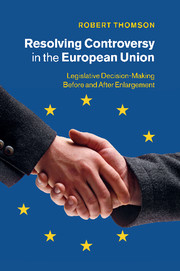 Resolving Controversy in the European Union
Resolving Controversy in the European Union Book contents
- Frontmatter
- Contents
- Figures
- Tables
- Acknowledgements
- 1 Introducing the political system of the European Union
- 2 Research design: measuring controversy spatially
- Part I Inputs
- Part II Processes
- 7 Transforming policy positions into decision outcomes
- 8 The relative power of the institutions
- 9 The relative power of the member states
- Part III Outputs
- 12 Evaluating and improving the European Union
- Appendix The selection of legislative proposals
- References
- Index
9 - The relative power of the member states
from Part II - Processes
Published online by Cambridge University Press: 07 October 2011
- Frontmatter
- Contents
- Figures
- Tables
- Acknowledgements
- 1 Introducing the political system of the European Union
- 2 Research design: measuring controversy spatially
- Part I Inputs
- Part II Processes
- 7 Transforming policy positions into decision outcomes
- 8 The relative power of the institutions
- 9 The relative power of the member states
- Part III Outputs
- 12 Evaluating and improving the European Union
- Appendix The selection of legislative proposals
- References
- Index
Summary
Large and small; old and new
This chapter assesses the relative power of the member states in the Council. Part of this assessment considers the relative power of large and small member states. Small states may have considerable power relative to large states in the European Union (EU). Small states have the same voting power as large states when the Council must adopt a legislative proposal by unanimity. In addition, even in policy areas where qualified majority voting (QMV) applies, small states have more power than their formal voting weights imply (e.g., Bunse et al. 2005). However, many observers hold the view that large states dominate the small in the EU. A realist view of EU decision-making attributes greater power to the larger states (e.g., Pedersen 1998). Even researchers who recognize that small states have considerable weight in the decision-making process also note that the large generally have more power than the small (e.g., Hayes-Renshaw and Wallace 2006: 252).
What is the relative power of old and new member states? The answer to this question is partly conflated with the assessment of large and small states’ relative power, because most of the new member states are small. In addition to their small size, new member states face the challenge of adapting to, and integrating into, the EU’s system of decision-making. The process through which policy demands are transformed into decision outcomes is defined by informal bargaining. To participate effectively in such informal processes, state representatives need strong relationships with representatives of other states. Such relationships take time to form. Consequently, new member states may be at a disadvantage to old members, at least in the period soon after their accession. It has been suggested that new member states have not had a marked influence on decision outcomes (Goetz 2005: 254), which may indicate that they have less power than the old members.
- Type
- Chapter
- Information
- Resolving Controversy in the European UnionLegislative Decision-Making before and after Enlargement, pp. 212 - 226Publisher: Cambridge University PressPrint publication year: 2011
